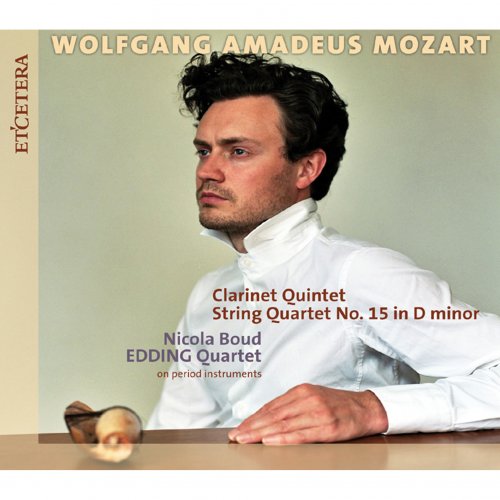
Nicola Boud, Edding Quartet - Mozart: Clarinet Quintet / String Quartet no. 15 in D Minor (2009)
BAND/ARTIST: Nicola Boud, Edding Quartet
- Title: Mozart: Clarinet Quintet / String Quartet no. 15 in D Minor
- Year Of Release: 2009
- Label: Etcetera
- Genre: Classical
- Quality: flac lossless
- Total Time: 01:01:47
- Total Size: 289 mb
- WebSite: Album Preview
Tracklist
01. Clarinet Quintet in A Major, KV 581: I. Allegro
02. Clarinet Quintet in A Major, KV 581: II. Larghetto
03. Clarinet Quintet in A Major, KV 581: III. Menuetto-Trio I-Trio II
04. Clarinet Quintet in A Major, KV 581: IV. Allegretto con variazioni
05. String Quartet No. 15 in D Minor, KV 421: I. Allegro moderato
06. String Quartet No. 15 in D Minor, KV 421: II. Andante
07. String Quartet No. 15 in D Minor, KV 421: III. Menuetto-Trio. Allegretto
08. String Quartet No. 15 in D Minor, KV 421: IV. Allegretto ma non troppo
Producing a historically accurate performance of Mozart's Clarinet Quintet in A major, K. 581, involves the use of the instrument for which the work was almost certainly written: the basset clarinet, whose invention was probably stimulated by Mozart's friend, clarinetist Anton Stadler. This instrument has several keys that extend its range downward as compared with a modern clarinet and gives the low notes in both this work and the Clarinet Concerto in A major, K. 622, a more natural sound. The instrument played by Australian clarinetist Nicola Boud is a modern reproduction (few original basset clarinets survive), and it has a piercing tone that sets off the unusual modulations in the first movement of the quintet (sample the beginning of the development section for an idea. The finale also has a much lighter, friskier effect than that familiar from conventional recordings of the work. The historical instruments played by the multinational Edding Quartet are not specified, but they would seem to have gut strings and Classical-era bows. The quartet's performance of the String Quartet in D minor, K. 421, is rather fragile, quite detailed, and melancholy rather than despairing. Both performances feel fresh and reveal plenty of inner-voice detail, and they can be recommended even to those with libraries containing several versions of these pieces. If you're wondering about the identity of the hipster pictured on the cover, it is a rather unlikely conception of Mozart by photographer Sarah Claes.
01. Clarinet Quintet in A Major, KV 581: I. Allegro
02. Clarinet Quintet in A Major, KV 581: II. Larghetto
03. Clarinet Quintet in A Major, KV 581: III. Menuetto-Trio I-Trio II
04. Clarinet Quintet in A Major, KV 581: IV. Allegretto con variazioni
05. String Quartet No. 15 in D Minor, KV 421: I. Allegro moderato
06. String Quartet No. 15 in D Minor, KV 421: II. Andante
07. String Quartet No. 15 in D Minor, KV 421: III. Menuetto-Trio. Allegretto
08. String Quartet No. 15 in D Minor, KV 421: IV. Allegretto ma non troppo
Producing a historically accurate performance of Mozart's Clarinet Quintet in A major, K. 581, involves the use of the instrument for which the work was almost certainly written: the basset clarinet, whose invention was probably stimulated by Mozart's friend, clarinetist Anton Stadler. This instrument has several keys that extend its range downward as compared with a modern clarinet and gives the low notes in both this work and the Clarinet Concerto in A major, K. 622, a more natural sound. The instrument played by Australian clarinetist Nicola Boud is a modern reproduction (few original basset clarinets survive), and it has a piercing tone that sets off the unusual modulations in the first movement of the quintet (sample the beginning of the development section for an idea. The finale also has a much lighter, friskier effect than that familiar from conventional recordings of the work. The historical instruments played by the multinational Edding Quartet are not specified, but they would seem to have gut strings and Classical-era bows. The quartet's performance of the String Quartet in D minor, K. 421, is rather fragile, quite detailed, and melancholy rather than despairing. Both performances feel fresh and reveal plenty of inner-voice detail, and they can be recommended even to those with libraries containing several versions of these pieces. If you're wondering about the identity of the hipster pictured on the cover, it is a rather unlikely conception of Mozart by photographer Sarah Claes.
As a ISRA.CLOUD's PREMIUM member you will have the following benefits:
- Unlimited high speed downloads
- Download directly without waiting time
- Unlimited parallel downloads
- Support for download accelerators
- No advertising
- Resume broken downloads


